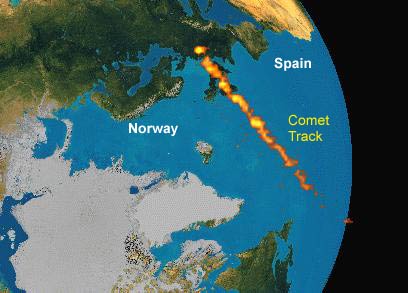Small Water
Comets?
A
controversial theory that the Earth is being bombarded constantly by
comet-like objects the size of small houses and consisting mostly of water has
received support from recent satellite
observations.
Cosmic Snowball Tracks?
In the image shown below
the
suspected track of such a cosmic snowball is captured by the
visible imaging system
of
the
Polar Satellite
as the object vaporized
at an altitude of 5,000 to 15,000 miles over the Atlantic Ocean
and Western Europe
in September, 1996.
Observations indicate
that these objects are vaporizing and leaving behind clouds
in
the atmosphere that are 10-100 kilometers across and have high
concentrations
of water vapor. This
interpretation
was first suggested in the mid-1980s from the UV satellite observation of
dark spots in the "dayglow"
(ultraviolet light produced by sunlight interacting with oxygen in the
atmosphere). Large clouds of water vapor would absorb the UV light at the
frequencies that the satellite was observing, thus leaving a dark spot or
"hole" in the dayglow.
Implications for History of Atmosphere and Oceans
If such a bombardment has continued for long periods,
it would have enormous implications for
our understanding of the origin and evolution of the Earth's atmosphere and
oceans, and perhaps for the evolution of life itself on the planet. For
example, the present estimated rate of this bombardment is of order 10 per
minute, with each event believed to deposit
20-40 tons (!) of water vapor in the upper
atmosphere.
This influx would add approximately 1 inch of water to the surface of
the Earth every 20,000 years.
If an appreciable fraction of
this rate has been sustained over the 4.5 billion year history of
the planet, such small comets might be responsible for all the
water in the oceans and in our atmosphere. Furthermore, there may might be
compounds other than water in the bombardment, which could have important
implications for various geochemical and biological cycles.
This would imply a rather different scenario than the
traditional one that our
atmosphere and oceans were
formed by gases emitted from the crust of the Earth after its
formation. Here is an
FAQ (list of
frequently asked questions) composed by proponents on this developing and still controversial
topic.

